I, Too, Saw Dreams Through Air is the official 2005 English language translation of a freeware Japanese visual novel released that same year as Yume Goshi no Sora. The original Japanese game was developed by 17, which remains active and is also behind Adagio, another visual novel that I have reviewed. The translation, completed by Insani, a prolific translation circle most active in the 2000s, was submitted to the inaugural al|together visual novel translation festival in 2005. I, Too, Saw Dreams Through Air is unusual in that it consists of two distinct short visual novels which have separate and distinct stories and settings.
The first novel of I, Too, Saw Dreams Through Air is The Caged Vagrant:

The second half of I, Too, Saw Dreams Through Air is Plumerai:

I am reviewing I, Too, Saw Dreams Through Air as part of my project to review nearly all of the visual novel translations submitted to the 2005, 2006, and 2008 al|together festivals. This is my 20th review of the project.
You can learn more about my al|together project by reading my project introduction article. That article includes a running list of our completed al|together reviews. I have a dedicated collection post with links to all of our al|together articles, including reviews, essays, and short posts.
I, Too, Saw Dreams Through Air features two dream-like short pieces. The first half of the novel, The Caged Vagrant, has the player take the role of an amnesiac communicating with a mysterious individual who has an empty bird cage for a head. The second novel, Plumerai, defies easy summary, but features a world wherein a cloud descends upon the world, and people marshal birds to attack the cloud.
I, Too, Saw Dreams Through Air Details
English version
| Title | I, Too, Saw Dreams Through Air |
|---|---|
| Translator | Irene Ying and Seung Park (Insani) |
| Release Date | December 6, 2005 |
| Engine | ONScripter-EN |
| Official Websites | Insani; al|together 2005 |
Japanese original
| Title | Yume Goshi no Sora |
|---|---|
| Developer | 17 |
| Notes | The Caged Vagrant is written by Yuki Plumerai is written by Ritsu |
| Original Release | April 9, 2023 |
| Engine | NScripter |
| Official Website | 17; Download |
Running and Installing I, Too, Saw Dreams Through Air
I, Too, Saw Dreams Through Air is, like most of the al|together translations, written in a version of ONScripter. It can be downloaded via torrent from the al|together 2005 site (the torrents work fairly well these days) for Windows, Linux, and MacOS, although the default Linux executable does not work on most modern systems, and my understanding is that the MacOS build does not work on modern MacOS. I tested the original Windows installer under WINE on Linux and it worked without issue. If you are unable to use the torrent, the Windows binary is available as a direct download from Kaisernet. You can extract the contents of the Windows exe to run it natively on other systems (see my guide).
Before continuing, note that while The Caged Vagrant and Plumerai collectively make up I, Too, Saw Dreams Through Air, they are functionally different games for purpose of running. There is a single Windows installer, but that installer installs The Caged Vagrant and Plumerai into separate sub-directories. Similarly, as I am about to explain on Linux, one must run ONScripter-EN separately in the directory for The Caged Vagrant and for Plumerai. They do not share assets or saves. The Caged Vagrant appears to be the first of the two novels, but the stories are not linked in such a way that one would have an issue playing Plumerai first.
While the packaged Linux binary no longer works, I was able to run both Caged Vagrant and Plumerai with almost no issue using a newer version of ONScripter-EN. I extracted the contents of the Windows .exe into a new directory and then ran a working ONScripter-EN binary individually. I successfully tested both novels with the following ONScripter-EN versions:
However, I ran into one minor sound issue on Linux. By default, ONScripter-EN games on Linux save in the user’s home directory. It is possible to designate a specific save path for ONScripter-EN games. I point all my games to save in a specific directory instead of Home. In the case of Plumerai (Caged Vagrant has no sound), designating a save path through the ONScripter configuration causes sound not to work on my Linux system. The game otherwise works perfectly fine. Sound worked when I did not designate a save path through the ONScripter configuration. (I do not know if this issue would also occur on Windows.)
General overview of I, Too, Saw Dreams Through Air
I, Too, Saw Dreams Through Air is made up of two distinct visual novels: The Caged Vagrant and Plumerai.
The Caged Vagrant has the player take the role of an amnesiac. He is greeted by a gentleman with an empty bird cage for a head. Mr. Bird Cage Head appears to know about the player and tries to help the player regain memories while sharing travel stories. The game has a distinct dream-like feel.
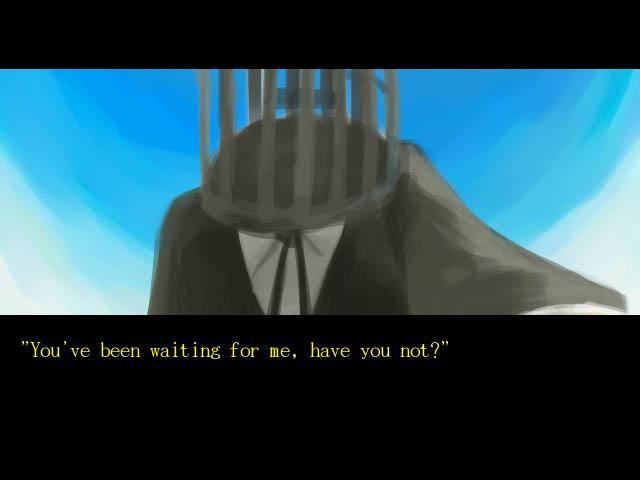
While The Caged Vagrant is not easy to describe without actually telling the story, it is straightforward in comparison to Plumerai. Plumerai, which features no character portraits, begins with a girl telling another character, who we are told is a bird martial, that she will be the next Plumerai.

The view-point character is somewhat confused because she understands the Plumerai to be a foreboding cloud reaching for the Earth – and that the people use birds to eat away at the Plumerai to keep it from reaching the Earth. The game then transitions to the next day, where we see the bird marshal at work and other characters on the day of the Plumerai battle (of sorts).
I, Too, Saw Dreams Through Air Review
I was half-inclined to review The Caged Vagrant and Plumerai separately – in part because they are, in many ways, separate and distinct, and also because I like one half of it (The Caged Vagrant) more than the other. However, because the two halves of I Too, Saw Dreams Through Air come as a package deal, I will review them both while ensuring that I clearly distinguish which I am talking about at each point.
Estimated Reading Time
I took many breaks to take screenshots while reading the two halves of I, Too, Saw Dreams Through Air, and thus did not read in the natural way that a player would read it for fun. Provided one does not miss the post-game content in The Caged Vagrant, it is the longer of the two novels, albeit I doubt that most readers will need more than 20-25 minutes to read through the entire thing. Plumerai lacks extra content and should take most readers somewhere in the neighborhood of 10-15 minutes, although subsequent readings may be required to put the plot in correct order.
Game-play and structure
I will examine the two halves of I, Too, Saw Dreams Through Air separately in this section.
The Caged Vagrant
The Caged Vagrant is an almost-entirely kinetic visual novel, meaning that it has a definite story – but there are a few caveats.
Firstly, The Caged Vagrant does involve several choices. Each of the choices prompts the player to ask the Bird Cage Head gentleman about one thing or another.
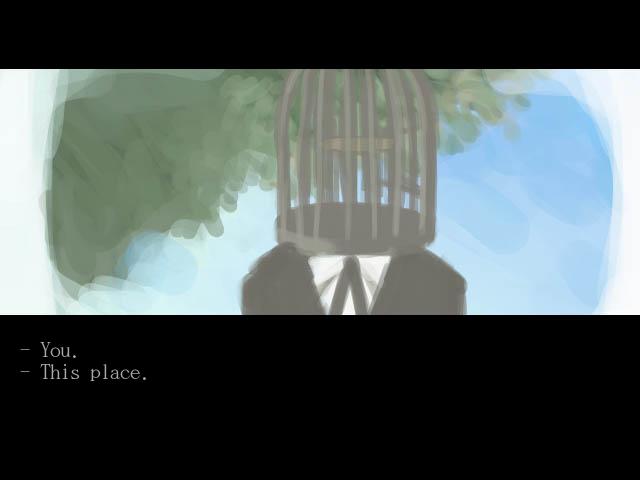
However, regardless of the player’s initial choice, he will then be prompted to choose the other option, meaning that the initial choice only determines which dialogue the player sees first. The choices do not otherwise change the story.
Secondly, as I will note in more detail later in the review, The Caged Vagrant has two false endings of sorts which are not immediately obvious. If the player reads through the story once, he or she is taken to the main title screen. It is not immediately obvious that starting a new game means starting a new chapter, and this process must be repeated several times to see the full story. There is also a title screen Easter Egg after reading the full story (see discussion).
Plumerai
Plumerai is an entirely linear and kinetic visual novel, with no player input beyond advancing the text during reading portions. However, Plumerai is broken into five chapters.

In between chapters, the player is presented with a choice to re-read the previous chapter or advance to the next chapter. Note that the chapters are short (to be expected of a visual novel that can be read in 10-15 minutes).
Visual Presentation
While The Caged Vagrant and Plumerai are two halves of the same novel, they do not look similar . For that reason, I will again separate them for purpose of the visual review.
The Caged Vagrant
I previously reviewed the al|together 2006 translation of another one of 17’s visual novels, Adagio. While I reviewed Adagio first and it was translated after I, Too, Saw Dreams Through Air, Adagio was 17’s first release in Japan. While Adagio as a whole (note it takes 5-10 minutes to read) did not leave much of an impression on me, I praised it for having visually appealing backgrounds with a distinct oil painting aesthetic.
One look at The Caged Vagrant will make it obvious that we are dealing with the same team behind Adagio. However, I dare say The Caged Vagrant is a step up in the visual aesthetics department, returning the same hazy, dream-like water painting effect as Adagio, but with more backgrounds, detail, and characters.
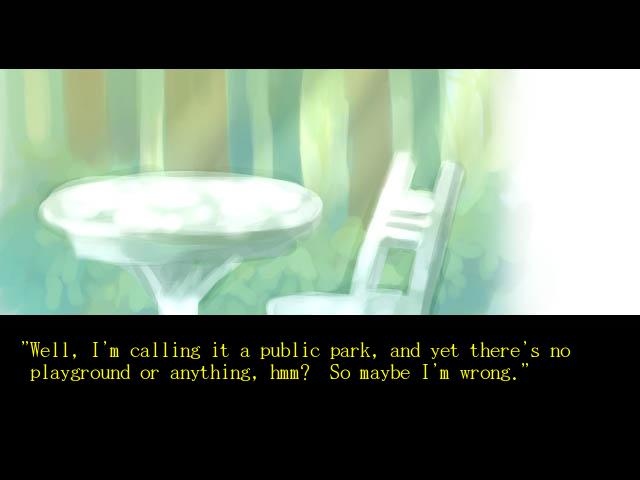
The Caged Vagrant is based on its author’s strange dream, and it uses its art to effectively convey a dream-like atmosphere with fairy tale elements.
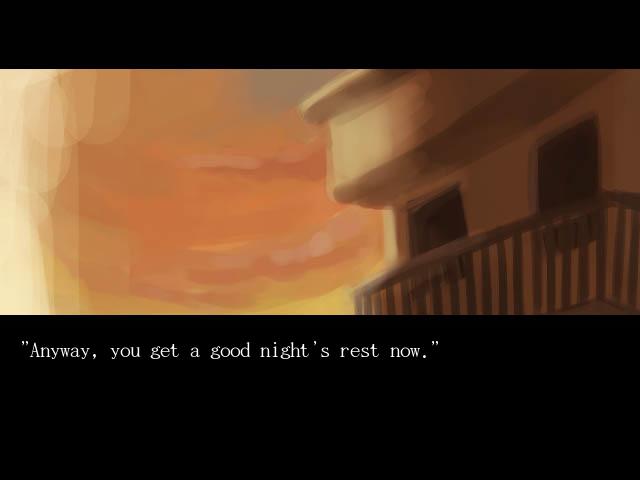
Unlike Adagio, wherein text overlaid its backgrounds (a common style for older NScripter/ONScripter visual novels), The Caged Vagrant makes effective use of letter-boxing to separate the text from the image, which is welcome given that many of the images feature the Bird Cage Man or a malevolent -looking fairy tale cat.
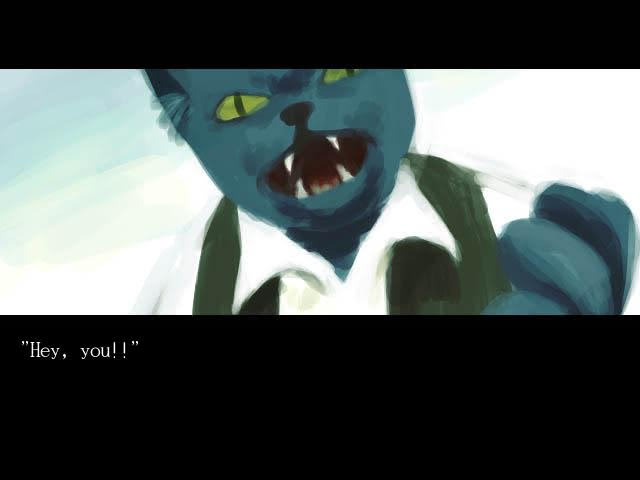
The letter-boxing effect is unusual in the al|together set of videos, although we did see it used well in A Winter’s Tale.
There are some scenes, mostly relegated to the post-game content, wherein text overlays backgrounds. This gives rise to my one complaint – the translation of Caged Vagrant sometimes uses white text on top of light gray/off-white backgrounds. While I was able to read it, I will venture that this unfortunate configuration would not pass accessibility muster.

Finally, I will note that the title page and menus use the distinct, soothing art style that we see in the game proper.

All-in-all, The Caged Vagrant is one of the most visually interesting al|together projects, and the one which gives off the strongest fairy tale aesthetic (even more so than The Poor Little Bird, which is very much a fairy tale-type story).
Plumerai
Plumerai has a different visual set-up than A Caged Vagrant. While the background art maintains the same water color style as Caged Vagrant and Adagio, it is crisper and less hazy.
Unlike The Caged Vagrant, there are no depictions of characters in the background art of Plumerai other than a bird silhouette in one scene.

Plumerai is not as visually distinct or striking as either Adagio or Caged Vagrant, but its backgrounds are distinctly above average by the standards of the al|together reviews. The bird silhouette scene and the starry background in the opening scene (which reminded me of some of Mr. Makoto Shinkai’s otherworldly art in act two of 5 Centimeters Per Second) were the stand-outs.
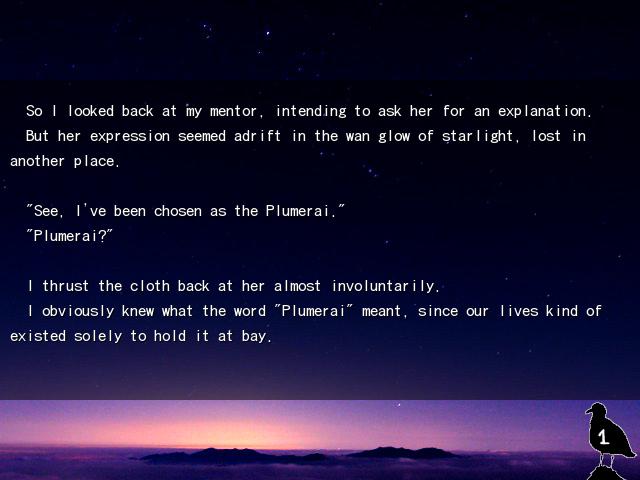
Some of the cloud backgrounds did run together, although they are all solid individually.
Plumerai handles texts differently than both Adagio and Caged Vagrant. Like Adagio, text overlays the background. However, like Caged Vagrant, there is a text box – here being a mostly translucent box leaving the background visible but setting the text apart from it. This style is used in al|together 2006’s A Dream of Summer.
The most fun visual aspect of Plumerai is a little black bird in the bottom-right corner of the screen with a number written on it. The number indicates the in-game chapter.
Music
The translation of The Caged Vagrant has no music, which is unfortunate. My understanding is that the original Japanese version has music, so enterprising players who can read Japanese may want to download and run the original Japanese game.
Plumerai has distinct sound tracks for each chapter. Each track was pleasant enough, but I never felt that the score perfectly matched what was happening in Plumerai or set a clear mood for the novel.
Translation quality
I, Too, Saw Dreams Through Air was translated by Ms. Irene Ying of Insani, under the supervision of Mr. Seung Park. I preface all of my translation reviews by noting that I not only have not read the original Japanese script, but I also cannot read Japanese. Thus, I can only review how the novels read in English and what seem to be any very obvious liberties taken with the conversation.
Both halves of I, Too, Saw Dreams Through Air read well in English and lack any jarring errors. I will single out The Caged Vagrant, which likes to take an indirect, roundabout approach to explaining itself, as a terrific effort – in that it is both vague (as I assume it is in Japanese) and also relatively easy to follow for an attentive reader.
I had some issues with Plumerai, but I will venture that the issues originated in the original Japanese game rather than result from the translation. Plumerai takes The Caged Vagrant’s vagueness to another level, but unlike The Caged Vagrant, I found it difficult to keep track of who was speaking or acting in different scenes – even with the aid of chapter demarcations. Plumerai would have benefited from designating speakers in a text box, but that was obviously not part of the novel’s original design.
Writing and story quality
I will review each half separately since they have distinct stories.
The Caged Vagrant
I did not go into The Caged Vagrant with high expectations, based largely on the fact that Adagio did not rank high on my list of favorite al|together novels. However, I came away very pleasantly surprised with the piece.
The piece was apparently inspired by a dream that the author had, and the dream inspiration is clear in its presentation.

We have the player, an unnamed protagonist, waking up in a world having forgotten everything. There he meets a man in a suit with a bird cage for a head who seems to know him and wants to jog his memory and share stories. The player meets regularly with the caged vagrant, listening to stories about the caged vagrant’s travels and, eventually, discussing what it means to have something to live for. However, all of the dialogue in the main game is delivered by the caged vagrant – for example we see his responses to the player but not what the player says.

Despite the odd set-up, Caged Vagrant is coherent and easy to follow. Nothing is too surprising in light of the fact that the only talking character has a bird cage for a head, talks about looking for something, and we meet an intimidating looking fairy tale cat. But while foreshadowing makes some events predictable, the script is well-executed.
Had The Caged Vagrant ended with its main story, it would have already been an above average al|together entry, but it tacked on several afterword stories, told from the perspectives of the various characters. These stories are effective, albeit not nearly as compelling as the main game, and they expand on some of the central ideas about The Caged Vagrant, namely, seeking and finding something to live for, and living well.
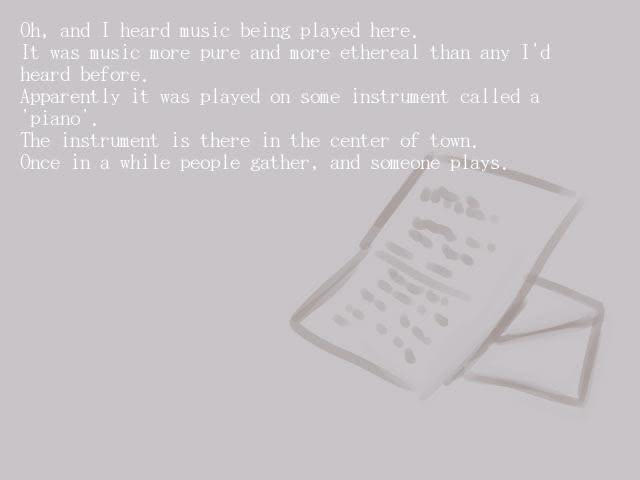
One issue I had with Adagio, despite its audio-visual merits, was that it was not clear to me what I was supposed to take from reading it. The Caged Vagrant makes effective use of subtlety, showing the reader a dreamy tale and but not being so vague as to obfuscate its theme and message.
Plumerai
After having come away with a positive view of The Caged Vagrant, I held out similar hopes for Plumerai. Unfortunately, I came away from reading Plumerai not quite sure what to do with it.
I read Plumerai about three times. Moreover, I read its 0.txt file (which contains the script and game configuration) to study the script without novel distractions. While I was generally able to piece together what was happening and when in a broad sense, I must confess I am still at a bit of a loss.

In light of the fact that The Caged Vagrant is based on a dream (per the author’s own admission) and Plumerai is bundled with it, I think Plumerai is also based on a dream (note it has a different author, but the same artist), but an afterword from the author would have been more helpful.
To be sure, a dream-based visual novel can be abstract and leave some questions unanswered. The Caged Vagrant is certainly abstract in its own way. But Plumerai is let down somewhat by its incomplete world-building, winding list of speakers, and ambiguous messaging. The script describes action in the middle chapters (2-4), but it does little to convey it with feeling.

As I noted in the translation section, it is difficult to tell who is talking and who is doing what in Plumerai, and this difficulty is enhanced by the fact we are immediately thrown straight into a strange, unfamiliar world with characters who we do not know. That works decently well in The Caged Vagrant in that the character list is short and it does an effective job of conveying to the reader what is important to understanding the dreamy tale. I spent my initial efforts trying to make sense of what was happening in Plumerai, and that was enough of a struggle to preclude me from trying to figure out what the message of the novel was.
Some readers may glean a bit more from Plumerai than I did (if you are one such reader, feel free to tell me what you think I missed), but on the whole I consider it to be something of a curiosity bundled with the genuinely good Caged Vagrant as part of I, Too, Saw Dreams Through Air.
True endings and Easter eggs in Caged Vagrant
In my review of Red Shift, which was one of the longer al|together novels, I noted that it is possible to miss the game’s ending scene if one assumes that the novel is over when the credits run. That would be a shame in Red Shift in light of the fact that the ending scene is important and the novel takes a solid three hours to read.
The Caged Vagrant, like Red Shift, has an easy-to-overlook ending. However, the ending is not easy to miss because some people do not sit for credits, but instead because the game is ambiguously designed.
Many al|together visual novels offer new content after a game is completed. For example, May Sky has an epilogue story which on its own is longer than nearly all of the al|together novels. The option to read the epilogue is clearly available on the start menu after finishing the main game. Similarly, Instant Death! Panda Samurai, io [Christmas Eve], and A Winter’s Tale include epilogues in which the author talks to readers that are made plainly available on the start menu after completing the main game (the latter author’s epilogue in A Winter’s Tale prompted an entire research project).
The Caged Vagrant’s story does not end after reading the main game, but good luck to a reader trying to figure that out intentionally. After reading the main story, the player is returned to the start menu. However, the start menu does not include a new option: It still has Start, Load, and End. I initially assumed that the absence of new options meant the game was over. However, if one presses Start a new scene begins that is separate from the original story. After reading that scene, the player is once again returned to the same main menu, and pressing start opens yet another new scene. It turns out that there are three epilogue scenes in total.
Thus…
- After completing the game and returning to the start menu, press “Start” to see the first epilogue scene
- Repeat this two more times after the first epilogue scene
After seeing all three epilogue scenes, pressing start yet again will allow the player to choose between restarting the main game (The Caged Vagrant) or returning to one of the three epilogue scenes.
While this confusion stemmed from a questionable design choice, the creator, 17, intentionally included an Easter Egg with four additional hard to find scenes (one being 17 talking to the reader). Because this Easter Egg is deliberate and I try to keep my review free of spoilers, I will not reveal exactly how to find it.

However, having noted that I only found the Easter Egg because I used machine translation on the original Japanese page for I, Too, Saw Dreams Through Air, I decided to make the tip available here at The New Leaf Journal. However, as to not advantage any readers who want to look without any help at all, I am including the tip as a link instead of putting it in the body of the article (see tip).
Conclusion
The Caged Vagrant is a well-done dream piece and, based on its strengths alone, I, Too, Saw Dreams Through Air is one of the easier al|together visual novels to recommend to general audiences. It is well-written, has a distinctive art style, and the inclusion of a certain Easter Egg adds to its charm. Plumerai is clearly the weaker half of the Dreams Through Air duo, but it is worth a try (and possible struggle) for readers who go through the effort of downloading the novels and reading The Caged Vagrant.
